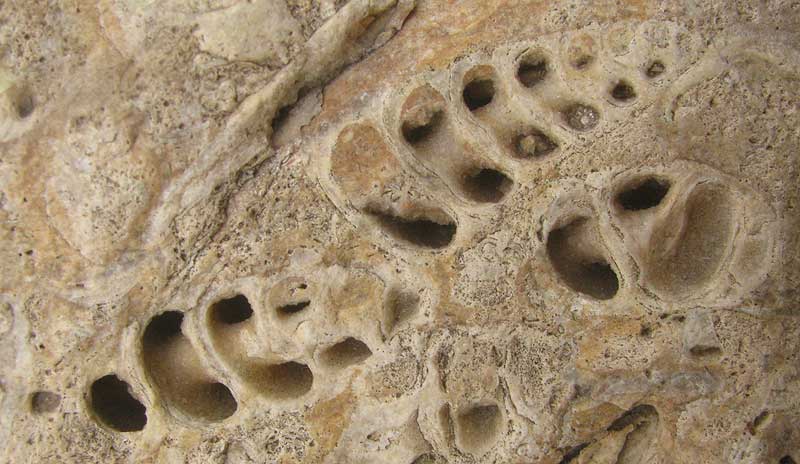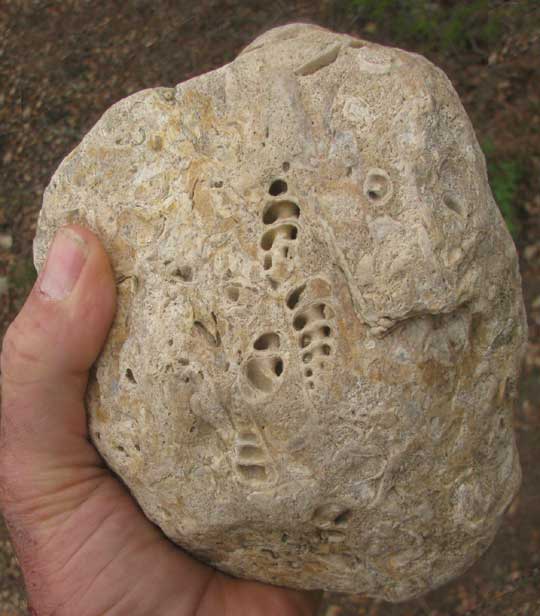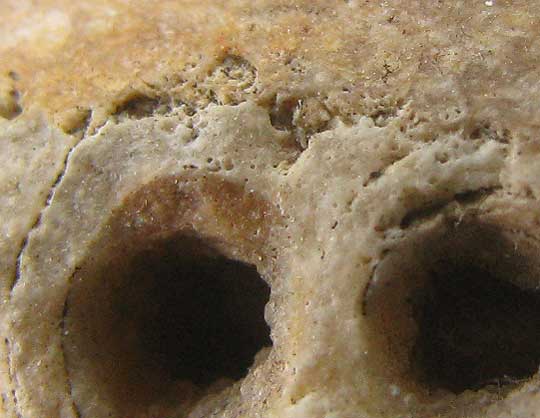Excerpts from Jim Conrad's
Naturalist Newsletter

from the April 13, 2014 Newsletter issued from the Frio Canyon Nature Education Center in the valley of the Dry Frio River in northern Uvalde County, southwestern Texas, on the southern border of the Edwards Plateau; elevation ~1750m (~5750 ft); N29.62°, W99.86°; USA
FOSSIL TURRITELLA SHELLS
In the cobblestone-strewn floodplain of the upper Dry Frio I came upon the limestone rock shown below:

Without lab analysis you can't ever know for sure a loose rock's geological age, because it might have come from anywhere. However, being found where it was, it was surely early Cretaceous, like all the limestone bedrock in the area, so the fossils in the rock are remnants of animals that lived about 110 million years ago. The rock contains many fossils and fossil fragments, but a close-up of the three most conspicuous appears at the top of this page.
The rock has broken or eroded so that nice longitudinal sections are provided of the ancient animals' shells. It's as if we had cut the shells down their centers, end to end, enabling us to see how the shells' "whorls" spiral around the interior column-like "columellae" (singular columella). The shell is similar to some found on beaches in the Yucatan, so we know that the whorls end at an opening at the bottom of the shell, called the "aperture," through which the animal's soft body extends when it's not drawn into the shell for protection.
Animals with shells like this are mollusks, and mollusks whose soft bodies extend through an aperture at the shell's bottom are gastropods. Snails are the most familiar gastropods.
In my little Golden Nature Guide to fossils the shell most resembling ours is a gastropod known as Turritella. Turritellas, which in geologic time have lived from the Cretaceous to the present, are described as "... slender, high-spired shells with incised sutures and with spiral or transverse ornament."
By "incised sutures," is meant that between the spire's whorls the point of contact is a bit indented. The words "with spiral or transverse ornament," sent me looking with the hand lens to see what's shown below:

The top of that picture is occupied by limestone rock, in which the fossils are embedded. The two dark areas are cavities within one of the fossil shell's two whorls. You can see two "incised sutures" between the two whorls, plus between each incised suture the shell's surface where it makes contact with the limestone bears many small points. Each point is a cross section of a slender ridge spiraling across the shell's surface.These spiraling fine ridges are the "spiral or transverse ornament," and they are a feature of Turritella shells.
My little Golden Nature Guide, though wonderful, is mainly a child's book, so to firm up the identification I submitted pictures to the identification section of TheFossilForum.Com.
In a few hours Herb in Kentucky wrote, "They appear to be Turritella," and that tickled me. A few hours later, though, Erose in Texas added, "Cerithium would be another suspect," so now the issue wasn't as certain as I'd hoped. Not long after, Herb in Kentucky agreed, writing "another possibility also. Hard to say as they have been massively recrystalized."
Both Turritella and Cerithium are often found as fossils in rocks, and species of the genera still roam the ocean floor. However, after viewing many pictures on the Internet of both genera, to me the shells in our rock are much more like Turritella than Cerithium.
So, that's how I'm filing this entry on the Internet: as TURRITELLA, in early Cretaceous rocks either of the Edwards Limestone or Glen Rose Formations.
Turritellas often are called Tower Shells.